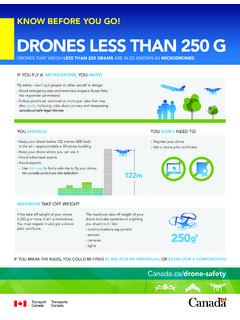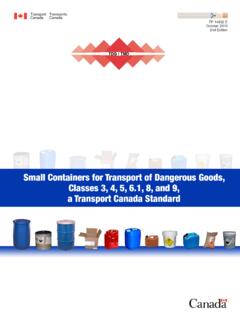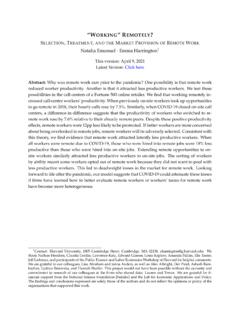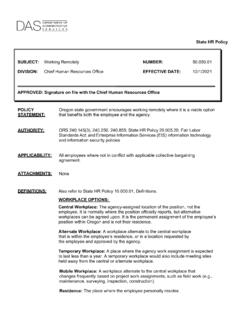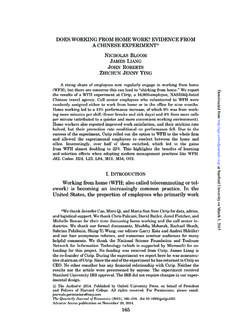Transcription of Knowledge Requirements for Pilots of Remotely Piloted ...
1 I TP 15263E (June 1, 2019) Knowledge Requirements for Pilots of Remotely Piloted Aircraft Systems 250 g up to and including 25 kg, Operating within Visual Line-of-Sight (VLOS) Third Edition June 1, 2019 RDIMS 12871687 ii Please direct your orders and inquiries to: The Order Desk Operational Support Services Transport Canada (AAFBD) 330 Sparks Street Ottawa ON K1A 0N8 Telephone: 1-888-830-4911 (in North America) 613-991-4071 (other countries) Fax: 613-991-1653 E-Mail: Her Majesty the Queen in Right of Canada, as represented by the Minister of Transport, 2018. Permission is granted by the Department of Transport, Canada, to copy and/or reproduce the contents of this publication in whole or in part provided that full acknowledgment is given to the Department of Transport, Canada, and that the material be accurately reproduced.
2 While use of this material has been authorized, the Department of Transport, Canada, shall not be responsible for the manner in which the information is presented, nor for any interpretations thereof. The information in this publication is to be considered solely as a guide and should not be quoted as or considered to be a legal authority. It may become obsolete in whole or in part at any time without notice. TP 15263E (Revised 6/2019) You may reproduce this guide as required and it can be found at iii TABLE OF CONTENTS Enquiries .. iv Recommended study material .. iv Preamble .. v Small RPAS pilot Knowledge Requirements .. vii Knowledge areas .. 9 Section 1: air law, air traffic rules and procedures .. 9 Section 2: RPAS airframes, power plants, propulsion and systems .. 18 Section 3: Human factors .. 22 Section 4: Meteorology .. 24 Section 5: Navigation.
3 28 Section 6: Flight operations .. 31 Section 7: Theory of flight .. 35 Section 8: Radiotelephony .. 38 Appendix A: Flight reviewer s guide - sRPAS exercises .. 39 iv Enquiries Information concerning the operation of small RPASs and pilot certification may be obtained by contacting the appropriate Transport Canada Regional Offices. A complete listing may be found at: Recommended study material Transport Canada publications (TP), including the following, may be purchased from retailers, or at the following web site: Human Factors for Aviation - Basic Handbook (TP 12863), and Advanced Handbook (TP 12864) Transport Canada Aeronautical Information Manual (TC AIM) (TP14371) The Study Guide for the Radiotelephone Restricted Operator Certificate - Aeronautical (RIC-21) is available free of charge from district offices of Industry Canada - Examinations and Radio Licensing ( ).
4 Canadian Aviation Regulations (CARs) are available online at: NAV CANADA publications, including the following, may be purchased from retailers, or at the following web site: VFR Navigation Charts (VNC)/VFR Terminal Area Charts (VTA) Canada Flight Supplement The NAV CANADA VFR Phraseology guide is available for download at Information on the Transportation of Dangerous Goods is available from Transport Canada. Text books and other publications produced by commercial publishers can be obtained through local flying training organization, bookstores and similar sources. v Preamble This document was prepared by a joint Transport Canada/industry working group. This Knowledge document serves as the ground training and examination guide for Pilots of Remotely Piloted Aircraft Systems (RPAS). It is in accordance with the amendments to the Canadian Aviation Regulations (CARs) for sRPAS operations that are to come into force in 2018/2019.
5 This guide covers the Knowledge required to operate sRPAS in Canada. It is not necessarily a comprehensive list sRPAS operating and training organizations may find the need to supplement these topics. The written examinations, as set by Transport Canada, will be in accordance with the Knowledge listed in this document. Both this document and the examinations may be amended as required. Regulatory history The Canadian Aviation Regulatory Advisory Council (CARAC) Unmanned Aircraft System Program Design working Group made recommendations for the safe integration of sRPAS operations within visual line-of-sight (VLOS) in Canadian airspace. The key principles for sRPAS-related regulatory changes were approved by the CARAC Technical Committee in June 2012 and then by the Transport Canada Canadian Aviation Regulatory Committee (CARC) in October 2012. They were adopted as best practice guidance for Transport Canada Inspectors and applicants for a Special Flight Operations Certificate (SFOC) - Unmanned Aircraft Systems.
6 Those Best Practices have now been incorporated into regulations and standards that normalize the operation of sRPAS operating VLOS. This document is provided to guide trainers and Pilots in the training required, and the examinations subjects to be covered when operating sRPAS VLOS under the new CAR Part IX. vi New regulatory structure for RPAS RPAS will be regulated according to the CARs. Part IX of the CARs will deal with RPAS according to the divisions of mass and operating environments in the diagram below. The immediate regulations will cover RPAS with a MTOW of 250 grams ( lb) up to and including 25 kg (55 lb) operating VLOS. Operating environments will be subdivided in to basic operations and advanced operations Other operations using RPAS that do not fall within the scope of the regulations will require a Special Flight Operations Certificate RPAS from Transport Canada.
7 This includes operations during which the RPAS is operated beyond visual line-of-sight (BVLOS). General small RPAS exam information Where to write the examinations The examinations required for the operation of sRPAS may only be completed online via the Transport Canada Drone Management Portal. Examination prerequisites Candidates for exams must create an account on the Transport Canada Drone Management Portal. NOTE: Applicants must be able to read the examination questions in either English or French without assistance. Examination rules As per CARs , , and with respect to examinations related to RPAS: No person shall, (a) copy or remove from any place all or any portion of the text of the examination; (b) give help to or accept help from any person during the examination; or (c) complete all or any portion of the examination on behalf of any other person; vii Materials required The examinations are delivered via computer.
8 However, we suggest having a pencil and paper handy before beginning the examination, to make diagrams or execute calculations during the examination. Time limits and pass marks Examination Questions Time limit Pass mark Remotely Piloted Aircraft Systems Basic Operations: 35 1 hour 65% Remotely Piloted Aircraft Systems Advanced Operations: 50 1 hour 80% Remotely Piloted Aircraft Systems Flight Reviewers: 30 1 hour 80% Rewriting of examinations In the case of any examination for operation of sRPAS, the examination may be rewritten after 24 hours. Examination feedback Feedback statements in the results letter will inform the candidate where questions were answered incorrectly. Example of feedback statement: Identify classes of airspace from an aeronautical chart. Small RPAS pilot Knowledge Requirements Knowledge Requirements for sRPAS Pilots operating VLOS are shown in the following tables.
9 The applicable type of operation (basic and advanced) is shown to the left of the topics. Sample learning objectives are shown to the right of the topics. The list of sample objectives is not all-inclusive, its purpose is to illustrate the depth of Knowledge required to operate sRPAS in Canadian airspace. Types of operation (basic operations, advanced operations) are set out in the Canadian Aviation Regulations, Part IX. There are minimum Knowledge Requirements for the Pilots of sRPAS operating in each of those groups. Applicants for the pilot certificate small Remotely Piloted aircraft (VLOS) basic operations shall demonstrate their Knowledge by writing the Transport Canada multiple choice examination based on the indicated applicable subjects contained in this guide and covering the subjects set out in Standard Applicants for the pilot certificate small Remotely Piloted aircraft (VLOS) advanced operations shall demonstrate their Knowledge by writing the Transport Canada multiple choice examination based on viii the indicated applicable subjects contained in this guide and covering the subjects set out in Standard Applicants for the flight reviewer rating attached to the pilot certificate small Remotely Piloted aircraft (VLOS)
10 Advanced operations shall demonstrate their Knowledge by writing the Transport Canada multiple choice examination on the indicated applicable subjects contained in the Knowledge areas section of this guide related to advanced operations and Appendix A: Flight review guide - sRPAS exercises related to conducting a flight review covering the subjects set out in Standard 9 Knowledge areas Section 1: air law, air traffic rules and procedures Small RPAS type of operation Knowledge areas (topics) Sample learning objectives The small RPAS pilot operating within visual line of sight must be able to: Basic Advanced Aeronautics Act s3-Definitions Define aerodrome, airport, and pilot-in-command. Canadian Aviation Regulations (CARs) Part I General provisions 101 Interpretation Interpretation (definitions) Define common terms used in the Canadian Aviation Regulations, such as day, night, VFR.

